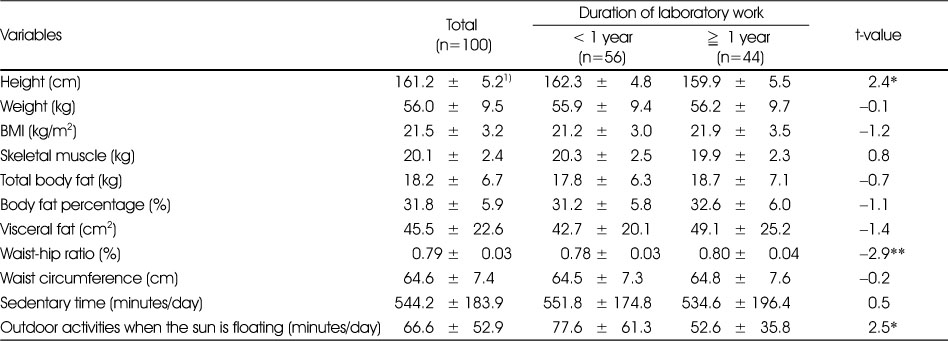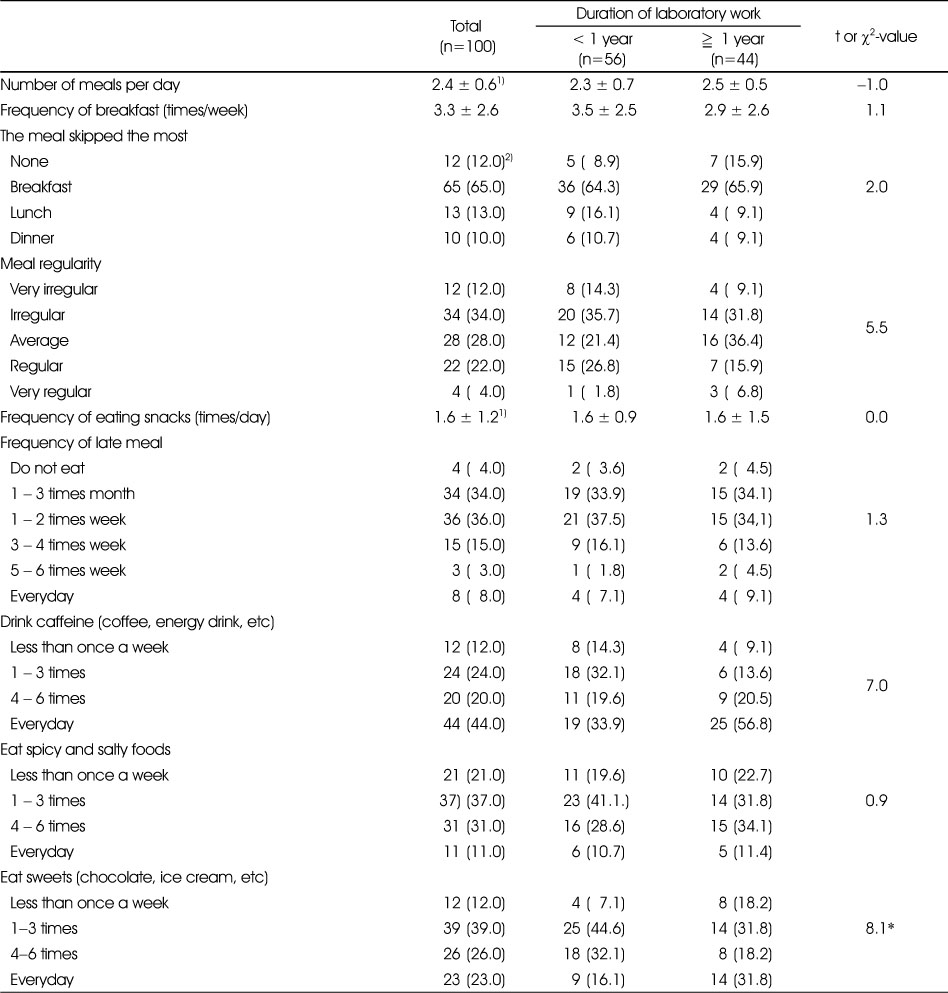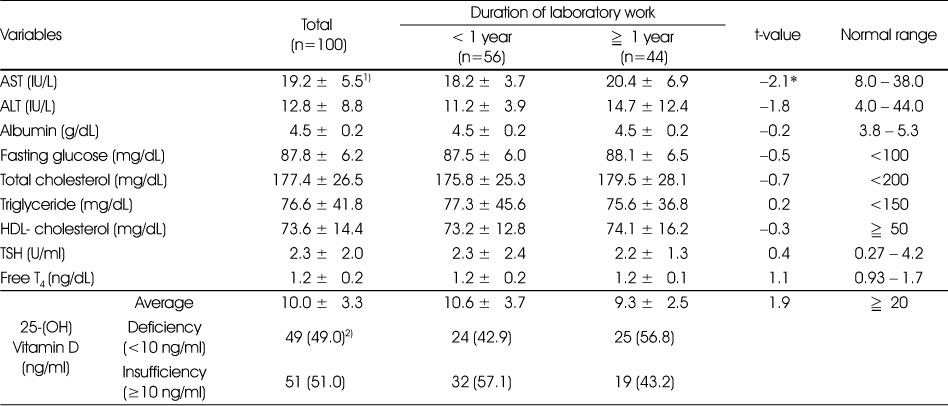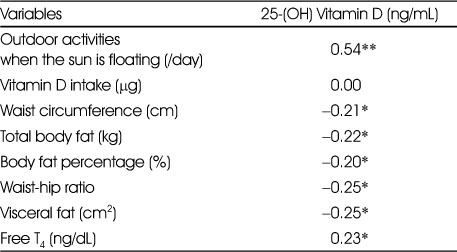Articles
- Page Path
- HOME > Korean J Community Nutr > Volume 24(3); 2019 > Article
-
Research Article
- Dietary Life, Vitamin D Status and Blood Clinical Indices of University Laboratory Workers
-
Jung Hyun Hwang
 , Hong Mie Lee
, Hong Mie Lee , Jung Hee Kim
, Jung Hee Kim
-
Korean Journal of Community Nutrition 2019;24(3):245-256.
DOI: https://doi.org/10.5720/kjcn.2019.24.3.245
Published online: June 30, 2019
1Department of Food and Nutrition, Seoul Women's University, Seoul, Korea, Student.
2Major in Nutrition Education, Graduate School of Education, Daejin University, Pocheon, Gyeonggi, Korea, Professor.
3Department of Food and Nutrition, Seoul Women's University, Seoul, Korea, Professor.
- Corresponding author: Jung Hee Kim. Department of Food and Nutrition, College of Natural Sciences, Seoul Women's University, 621 Hwarangno, Nowon-gu, Seoul 01797, Korea. Tel: (02) 970-5646, Fax: (02) 976-4049, jheekim@swu.ac.kr
Copyright © 2019 The Korean Society of Community Nutrition
This is an Open-Access article distributed under the terms of the Creative Commons Attribution Non-Commercial License (http://creativecommons.org/licenses/by-nc/3.0/) which permits unrestricted non-commercial use, distribution, and reproduction in any medium, provided the original work is properly cited.
- 386 Views
- 0 Download
Abstract
-
Objectives
- Although the number of laboratory workers is constantly increasing every year, few studies have been conducted on the health and nutritional status of these research workers. This study determined the health status of laboratory workers by analyzing their anthropometric indices, dietary life, vitamin D status and blood clinical indices.
-
Methods
- The subjects consisted of 100 female laboratory workers. This study investigated their diet, anthropometric indices, vitamin D status and blood clinical indices. The subjects were divided into two groups according to their duration of working in a laboratory (<1 year,≥1 year).
-
Results
- The average age and body mass index (BMI) of subjects were 23.18 years and 21.51 kg/m2, respectively Those subjects with over 1 year employment (≥1 year) had a significantly higher waist-hip ratio than that of the subjects with the less than 1 year employment (<1 year). The mean serum vitamin D level of all the subjects was 10.04 ng/mL, which is close to a level of vitamin D deficiency. There was a significantly higher average intake of calories in the over 1 year employment group as compared to that of the less than 1 year employment group. The frequency of eating sweet snacks was significantly higher for the over 1 year employment group. The correlation analysis showed a significant positive correlation between the serum 25-(OH)-vitamin D level and the time of exposure to sunlight, while dietary intake of vitamin D did not show correlation with the serum 25-(OH)-vitamin D level. However, the serum 25-(OH)-vitamin D level was also negatively correlated with both the percentage of body fat and visceral fat.
-
Conclusions
- Laboratory workers are a very high risk group in terms of their nutritional status of vitamin D. Therefore, they need greater time of exposure to sunlight as well as increasing their dietary consumption of vitamin D. In addition, it is important for laboratory worker to practice regular and balanced dietary habits in order to maintain a healthy life.
Acknowledgments
Acknowledgments
- 1. National Science & Technology Information Service. Research workers and manpower of research and development according to gender and main research institute [Internet]. Ministry of Science and ICT; 2014; cited 2016 Apr 20]. Available from: https://www.ntis.go.kr/rndsts/selectStatsDivIdctVo.do.
- 2. Byun HJ, Park JI. A review on chemical exposure and related health risks in laboratory workers. J Environ Health Sci 2010; 36(6): 441-455.Article
- 3. Rusnak JM, Kortepeter MG, Hawley RJ, Anderson AO, Boudreau E, Eitzen E. Risk of occupationally acquired illnesses from biological threat agents in unvaccinated laboratory workers. Biosecur Bioterror 2004; 2(4): 281-293.ArticlePubMed
- 4. Elliott L, Heederik D, Marshall S, Peden D, Loomis D. Incidence of allergy and allergy symptoms among workers exposed to laboratory animals. Occup Environ Med 2005; 62(11): 766-771.ArticlePubMedPMC
- 5. Occupational Safety and Health Administration. Laboratory safety guidance. United States of America: Department of Labor; 2011. p. 5-48.
- 6. Raskeviciene R, Maroziene S. Evaluation of occupational risk factors and laboratory workers' health in biochemical and clinical laboratories of hospitals of Kaunas city. Medicina (Kaunas) 2005; 41(6): 512-521.PubMed
- 7. Sheets CD, Harriman K, Zipprich J, Louie JK, Probert WS, Horowitz M, et al. Fatal meningococcal disease in a laboratory worker-California, 2012. Morb Mortal Wkly Rep 2014; 63(35): 770-772.
- 8. Ryou H, Kong JO, Lee HG, Lee SJ, Chu S, Jung Y, et al. The comparison of job stress factors, psychosocial stress and their association between research and manufacturing workers in an automobile research and developing company. Korean J Occup Environ Med 2009; 21(4): 337-345.ArticlePDF
- 9. Park H, Lee KS, Choi YB, Park KE, Lee SJ, Song JC. The relationship between temperament, character and job stress of researchers in science and engineering colleges. Korean J Occup Environ Med 2012; 24(2): 145-157.ArticlePDF
- 10. Torres SJ, Nowson CA. Relationship between stress, eating behavior, and obesity. Nutrition 2007; 23(11): 887-894.ArticlePubMed
- 11. Myoung JP, Kim HR, Choi WS, Jo SE, Lee BR, Koo JW, et al. Relation between employees' lifestyle and their health status in an electronics research and development company. Korean J Occup Environ Med 2009; 21(1): 1-9.ArticlePDF
- 12. Xu G, Sui X, Liu S, Liu J, Liu J, Li Y, et al. Effects of insufficient physical activity on mortality and life expectancy in Jiangxi province of China, 2007–2010. PLoS One 2014; 9(10): e109826.ArticlePubMedPMC
- 13. Booth FW, Roberts CK, Laye MJ. Lack of exercise is a major cause of chronic diseases. Compr Physiol 2012; 2(2): 1143-1211.ArticlePubMedPMCPDF
- 14. Rosen CJ. Vitamin D insufficiency. N Engl J Med 2011; 364(3): 248-254.ArticlePubMed
- 15. Lappe JM, Travers-Gustafson D, Davies KM, Recker RR, Heaney RP. Vitamin D and calcium supplementation reduces cancer risk: results of a randomized trial. Am J Clin Nutr 2007; 85(6): 1586-1591.ArticlePubMed
- 16. Gannagé-Yared MH, Chedid R, Khalife S, Azzi E, Zoghbi F, Halaby G. Vitamin D in relation to metabolic risk factors, insulin sensitivity and adiponectin in a young Middle-Eastern population. Eur J Endocrinol 2009; 160(6): 965-971.ArticlePubMed
- 17. Anderson JL, May HT, Horne BD, Bair TL, Hall NL, Carlquist JF, et al. Relation of vitamin D deficiency to cardiovascular risk factors, disease status, and incident events in a general healthcare population. Am J Cardiol 2010; 106(7): 963-968.ArticlePubMed
- 18. Oh K, Hu FB, Manson JE, Stampfer MJ, Willett WC. Dietary fat intake and risk of coronary heart disease in women: 20 years of follow-up of the nurses' health study. Am J Epidemiol 2005; 161(7): 672-679.ArticlePubMed
- 19. Chuang SC, Lee YC, Wu GJ, Straif K, Hashibe M. Alcohol consumption and liver cancer risk: a meta-analysis. Cancer Causes Control 2015; 26(9): 1205-1231.ArticlePubMedPDF
- 20. Asaria P, Chisholm D, Mathers C, Ezzati M, Beaglehole R. Chronic disease prevention: health effects and financial costs of strategies to reduce salt intake and control tobacco use. Lancet 2007; 370(9604): 2044-2053.ArticlePubMed
- 21. Kim HM. The study of general health status in laboratory workers [master's thesis]. Soonchunhyang University; 2013.
- 22. Olsen JM, Nesbitt BJ. Health coaching to improve healthy lifestyle behaviors: an integrative review. Am J Health Promot 2010; 25(1): e1-e12.ArticlePDF
- 23. Ahn Y, Kim KW. Beliefs regarding vegetable consumption, self-efficacy and eating behaviors according to the stages of change in vegetable consumption among college students. Korean J Community Nutr 2012; 17(1): 1-13.Article
- 24. Pérez-Rodrigo C, Aranceta J, Salvador G, Varela-Moreiras G. Food frequency questionnaires. Nutr Hosp 2015; 31: S3. 49-56.PubMed
- 25. Ministry of Health & Welfare. The Korean Nutrition Society. Dietary reference intakes for Koreans 2015. Sejong: Ministry of Health & Welfare; 2015.
- 26. Jiang SM, Lei XG, Jia L, Xu M, Wang SB, Liu J, et al. Unhealthy dietary behavior in refractory functional dyspepsia: a multicenter prospective investigation in China. J Dig Dis 2014; 15(12): 654-659.PubMed
- 27. Bellisle F. Meals and snacking, diet quality and energy balance. Physiol Behav 2014; 134: 38-43.ArticlePubMed
- 28. Milano W, De Rosa M, Milano L, Capasso A. Night eating syndrome: an overview. J Pharm Pharmacol 2012; 64(1): 2-10.PubMed
- 29. Marinac CR, Sears DD, Natarajan L, Gallo LC, Breen CI, Patterson RE. Frequency and circadian timing of eating may influence biomarkers of inflammation and insulin resistance associated with breast cancer risk. PLoS One 2015; 10(8): e0136240.ArticlePubMedPMC
- 30. Farshchi HR, Taylor MA, Macdonald IA. Beneficial metabolic effects of regular meal frequency on dietary thermogenesis, insulin sensitivity, and fasting lipid profiles in healthy obese women. Am J Clin Nutr 2005; 81(1): 16-24.PubMed
- 31. Jeong H, Hong S, Heo Y, Chun H, Kim D, Park J, et al. Vitamin D status and associated occupational factors in Korean wage workers: data from the 5th Korea national health and nutrition examination survey (KNHANES 2010–2012). Ann Occup Environ Med 2014; 26(1): 28-28.PubMedPMC
- 32. WHO Scientific Group on the Prevention and Management of Osteoporosis. Prevention and management of osteoporosis: report of a WHO scientific group. Geneva: World Health Organization; 2003.
- 33. Joh HK, Lim CS, Cho B. Lifestyle and dietary factors associated with serum 25-hydroxyvitamin D levels in Korean young adults. J Korean Med Sci 2015; 30(8): 1110-1120.PubMedPMC
- 34. Ministry of Health & Welfare. Korea Centers for Disease Control and Prevention. 2010 Korean National Health and Nutrition Examination Survey. Sejong: Ministry of Health & Welfare; 2011.
- 35. Lips P, van Schoor NM. The effect of vitamin D on bone and osteoporosis. Best Pract Res Clin Endocrinol Metab 2011; 25(4): 585-591.PubMed
- 36. Zittermann A. Vitamin D and cardiovascular disease. Anticancer Res 2014; 34(9): 4641-4648.PubMed
- 37. Obaidi J, Musallam E, Al-Ghzawi HM, Azzeghaiby SN, Alzoghaibi IN. Vitamin D and its relationship with breast cancer: an evidence based practice paper. Glob J Health Sci 2014; 7(1): 261-266.PubMedPMC
- 38. Roskies M, Dolev Y, Caglar D, Hier MP, Mlynarek A, Majdan A, et al. Vitamin D deficiency as a potentially modifiable risk factor for thyroid cancer. J Otolaryngol Head Neck Surg 2012; 41(3): 160-163.PubMed
- 39. Lips P, van Schoor NM, de Jongh RT. Diet, sun, and lifestyle as determinants of vitamin D status. Ann N Y Acad Sci 2014; 1317(1): 92-98.ArticlePubMed
- 40. Wacker M, Holick MF. Sunlight and Vitamin D: A global perspective for health. Dermatoendocrinol 2013; 5(1): 51-108.PubMedPMC
- 41. Holick MF, Binkley NC, Bischoff-Ferrari HA, Gordon CM, Hanley DA, Heaney RP, et al. Guidelines for preventing and treating vitamin D deficiency and insufficiency revisited. J Clin Endocrinol Metab 2012; 97(4): 1153-1158.ArticlePubMed
- 42. Kimlin MG. Geographic location and vitamin D synthesis. Mol Aspects Med 2008; 29(6): 453-461.
- 43. Tzotzas T, Papadopoulou FG, Tziomalos K, Karras S, Gastaris K, Perros P, et al. Rising serum 25-hydroxy-vitamin D levels after weight loss in obese women correlate with improvement in insulin resistance. J Clin Endocrinol Metab 2010; 95(9): 4251-4257.
- 44. Kim D, Kim J. Association between serum 25-hydroxyvitamin D levels and adiposity measurements in the general Korean population. Nutr Res Pract 2016; 10(2): 206-211.
- 45. Zhang Y, Zhang X, Wang F, Zhang W, Wang C, Yu C, et al. The relationship between obesity indices and serum vitamin D levels in Chinese adults from urban settings. Asia Pac J Clin Nutr 2016; 25(2): 333-339.
- 46. Mackawy AM, Al-Ayed BM, Al-Rashidi BM. Vitamin D deficiency and its association with thyroid disease. Int J Health Sci (Qassim) 2013; 7(3): 267-275.
- 47. Kmieć P, Sworczak K. Vitamin D in thyroid disorders. Exp Clin Endocrinol Diabetes 2015; 123(7): 386-393.
REFERENCES
Anthropometric indice and physical activity of subjects according to duration of laboratory work

Figure & Data
REFERENCES
Citations

General characteristics of subjects according to duration of laboratory work
*: p<0.05, **: p<0.01, ***: p<0.001 by Student t-test or χ2-test
1) Mean ± SD
2) Number of subjects, ( ): % of subjects
Anthropometric indice and physical activity of subjects according to duration of laboratory work
*: p<0.05, **: p<0.01 by Student t-test
1) Mean ± SD
2) Number of subjects, ( ): % of subjects
Nutrients intake of subjects according to duration of laboratory work
*: p<0.05, **: p<0.01
1) Measured by Student t-test
2) Measured by ANCOVA test adjusted for energy intake
3) Mean ± SD
4) % of energy intake derived from carbohydrate, protein and fat
Dietary behavior of subjects according to duration of laboratory work
*: p<0.05 by χ2-test
1) Mean ± SD
2) Number of subjects, ( ); % of subjects
Serum 25-(OH)-D level and blood clinical indices of subjects according to duration of laboratory work
*: p<0.05 by Student t-test
1) Mean ± SD
2) Number of subjects who have abnormal blood level, ( ): % of subjects
AST: Aspartate aminotransferase
ALT: Alanine aminotransferase
TSH: Thyroid stimulating hormone
T4: Thyroxine
Correlation coefficient between serum 25-(OH)-D level and several variables
*: p<0.05, **: p<0.01 by Pearson's correlation analysis
*: p<0.05, **: p<0.01, ***: p<0.001 by Student t-test or χ2-test 1) Mean ± SD 2) Number of subjects, ( ): % of subjects
*: p<0.05, **: p<0.01 by Student t-test 1) Mean ± SD 2) Number of subjects, ( ): % of subjects
*: p<0.05, **: p<0.01 1) Measured by Student t-test 2) Measured by ANCOVA test adjusted for energy intake 3) Mean ± SD 4) % of energy intake derived from carbohydrate, protein and fat
*: p<0.05 by χ2-test 1) Mean ± SD 2) Number of subjects, ( ); % of subjects
*: p<0.05 by Student t-test 1) Mean ± SD 2) Number of subjects who have abnormal blood level, ( ): % of subjects AST: Aspartate aminotransferase ALT: Alanine aminotransferase TSH: Thyroid stimulating hormone T4: Thyroxine
*: p<0.05, **: p<0.01 by Pearson's correlation analysis

 KSCN
KSCN





 PubReader
PubReader Cite
Cite


